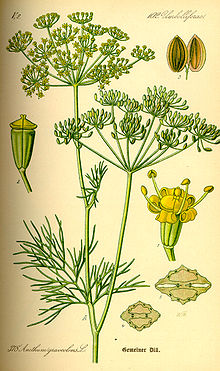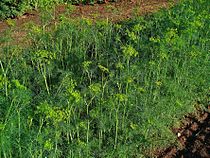- Dill
-
Dill 
Scientific classification Kingdom: Plantae (unranked): Angiosperms (unranked): Eudicots (unranked): Asterids Order: Apiales Family: Apiaceae Genus: Anethum
L.Species: A. graveolens Binomial name Anethum graveolens
L.Dill (Anethum graveolens) is a perennial herb. It is the sole species of the genus Anethum, though classified by some botanists in a related genus as Peucedanum graveolens (L.) C.B.Clarke.
Contents
Growth
40–60 cm (16–24 in), with slender stems and alternate, finely divided, softly delicate leaves 10–20 cm (3.9–7.9 in) long. The ultimate leaf divisions are 1–2 mm (0.039–0.079 in) broad, slightly broader than the similar leaves of fennel, which are threadlike, less than 1 mm (0.039 in) broad, but harder in texture. The flowers are white to yellow, in small umbels 2–9 cm (0.79–3.5 in) diameter. The seeds are 4–5 mm (0.16–0.20 in) long and 1 mm (0.039 in) thick, and straight to slightly curved with a longitudinally ridged surface.
Origins and history
Dill originated within an area around the Meditteranean and the South of Russia[1][2]. Zohary and Hopf remark that "wild and weedy types of dill are widespread in the Mediterranean basin and in West Asia."[3]
Although several twigs of dill were found in the tomb of Amenhotep II, they report that the earliest archeological evidence for its cultivation comes from late Neolithic lake shore settlements in Switzerland.[4] Traces have been found in Roman ruins in Great Britain.
In Semitic languages it is known by the name of Shubit. The Talmud requires that tithes shall be paid on the seeds, leaves, and stem of dill.
Nomenclature and taxonomy
The name dill comes from Old English dile, thought to have originated from a Norse or Anglo-Saxon word dylle meaning to soothe or lull[citation needed], the plant having the carminative property of relieving gas. In Romania it is called Mărar.
Uses
Dill weed, fresh Nutritional value per 100 g (3.5 oz) Energy 180 kJ (43 kcal) Carbohydrates 7 g - Dietary fiber 2.1 g Fat 1.1 g Protein 3.5 g Vitamin A 7717 (154%) IU Thiamine (vit. B1) 0.1 mg (9%) Riboflavin (vit. B2) 0.3 mg (25%) Niacin (vit. B3) 1.6 mg (11%) Pantothenic acid (B5) 0.4 mg (8%) Vitamin B6 0.2 mg (15%) Folate (vit. B9) 150 μg (38%) Vitamin B12 0 μg (0%) Vitamin C 85 mg (102%) Calcium 208 mg (21%) Iron 6.6 mg (51%) Magnesium 55 mg (15%) Manganese 1.3 mg (62%) Phosphorus 66 mg (9%) Potassium 738 mg (16%) Sodium 61 mg (4%) Zinc 0.9 mg (9%) Copper 0.1 (7%) Percentages are relative to US recommendations for adults.
Source: USDA Nutrient DatabaseFresh and dried dill leaves (sometimes called "dill weed" to distinguish it from dill seed) are used as herbs, mainly in Sweden, the Baltic, in Russia, and in central Asia.
Like caraway, its fernlike leaves are aromatic and are used to flavor many foods, such as gravlax (cured salmon), borscht and other soups, and pickles (where the dill flower is sometimes used). Dill is best when used fresh, as it loses its flavor rapidly if dried; however, freeze-dried dill leaves preserve their flavor relatively well for a few months.
Dill seed is used as a spice, with a flavor somewhat similar to caraway but also resembling that of fresh or dried dill weed. Dill seeds were traditionally used to soothe the stomach after meals.[5] Dill oil can be extracted from the leaves, stems and seeds of the plant.
In Arabic, dill seed is called ain jaradeh (means cricket eye) used as a spice in cold dishes like fattoush and pickles.
In Lao cuisine and parts of northern Thailand, dill is known in English as Laotian coriander[6] and Lao cilantro (Lao: ຜັກຊີ, Thai: ผักชีลาว). In the Lao language, it is called Phak See, and in Thai, it is known as Phak Chee Lao.[7] In Lao cuisine, the herb is typically used in mok pa (steamed fish in banana leaf) and several coconut milk-based curries that contain fish or prawns.
In Vietnam, the use of dill in cooking is regional, specifically northern Vietnamese cuisine.
In Iran, dill is known as "Shevid" and is sometimes used with rice and called "Shevid-Polo".
In India, dill is known as 'Savaa' in Hindi or 'Soa' not related to Soy, in Punjabi. In Telugu it is called soya and soya-kura (for herb greens). It is also called 'sapsige soppu' (ಸಪ್ಸಿಗೆ ಸೊಪ್ಪು) in Kannada. In Tamil it is known as Sada kuppi(சதகுப்பி). In Malayalam, it is ചതകുപ്പ(Chathakuppa)or ശതകുപ്പ(Sathakuppa). In Sanskrit, this herb is called Shatapushpa. In Gujrati it is known as hariz. In India, dill is prepared in the manner of yellow Moong dal as a main-course dish. It is considered to have very good anti-gas properties, and hence it is used as mukhwas, or an after-meal digestive. It is also traditionally given to mothers immediately after childbirth.
In Serbia, dill is known as "Mirodjija" and used in addition to soups and dishes, also in potato salads and French fries.
In Canada, dill is a favourite herb to accompany poached salmon.
In Santa Maria, Azores, dill (Endro) is the most important ingredient of the traditional Holy Ghost soup (Sopas do Espírito Santo). Dill is found practically anywhere in Santa Maria, and curiously rare in the other Azorean Islands.
Cultivation
Successful cultivation requires warm to hot summers with high sunshine levels; even partial shade will reduce the yield substantially. It also prefers rich, well drained soil. The seeds are viable for 3–10 years.[citation needed].
The seed is harvested by cutting the flower heads off the stalks when the seed is beginning to ripen. The seed heads are placed upside down in a paper bag and left in a warm dry place for a week. The seeds then separate from the stems easily for storage in an airtight container.
Companion Planting
When used as a companion planting, dill draws in many beneficial insects as the umbrella flower heads go to seed. Fittingly, it makes a good companion plant for cucumbers. It is a poor companion for carrots and tomatoes.[8]
Aroma profile
Toxicology
- Antibacterial potent of Staphylococcus aureus[11][clarification needed]
- Antimicrobial activity against Saccharomyces cerevisiae[14][15]
Notes and references
- ^ Mrs M.Grievefrom a text first published 1931 © Copyright Protected 1995-2011 Botanical.com retrieved 13:11 2011-11-04
- ^ @Copyright 2010 Olde Thompson Inc. retrieved 13:19 2011-11-04
- ^ Zohary and Hopf, page 206.
- ^ Zohary, Daniel; Hopf, Maria (2000). Domestication of plants in the Old World (3rd ed.). Oxford: Oxford University Press. pp. 206. ISBN 0198503571.
- ^ Whole Foods Profile
- ^ Davidson, A. (2003). Seafood of South-East Asia, 2nd edition. Ten Speed Press.
- ^ Ling, K. F. (2002). The Food of Asia. Periplus Editions.
- ^ "The Self-Sufficient Gardener Podcast Episode 17 My Favorite Herbs - Dill". http://theselfsufficientgardener.com/2010/08/14/episode-17-my-favorite-herbs-dill/.
- ^ Bailer, Josef et al. (2001). "Essential oil content and composition in commercially available dill cultivars in comparison to caraway". Industrial Crops and Products (Elsevier) 14 (3): 229–239. doi:10.1016/S0926-6690(01)00088-7.
- ^ Santos, Pedro A.G. et al.; Figueiredo, A. Cristina; Lourenço, Pedro M.L.; Barroso, José G.; Pedro, Luis G.; Oliveira, M. Margarida; Schripsema, Jan; Deans, Stanley G. et al. (2002). "Hairy root cultures of Anethum graveolens (dill): establishment, growth, time-course study of their essential oil and its comparison with parent plant oils". Biotechnology Letters (Springer) 24 (12): 1031–1036. doi:10.1023/A:1015653701265.
- ^ a b Singh, Gurdip et al.; Maurya, Sumitra; Lampasona, M.P.; Catalan, C. (2005). "Chemical Constituents, Antimicrobial Investigations, and Antioxidative Potentials of Anethum graveolens L. Essential Oil and Acetone Extract: Part 52". Journal of Food Science (John Wiley & Sons) 70 (4): M208–M215. doi:10.1111/j.1365-2621.2005.tb07190.x. http://doi.wiley.com/10.1111/j.1365-2621.2005.tb07190.x. Retrieved 28 July 2009.
- ^ a b c Dhalwal, Kamlesh et al.; Shinde, Vaibhav M.; Mahadik, Kakasaheb R. (2008). "Efficient and Sensitive Method for Quantitative Determination and Validation of Umbelliferone, Carvone and Myristicin in Anethum graveolens and Carum carvi Seed". Chromatographia (Springer) 67 (1 – 2): 163–167. doi:10.1365/s10337-007-0473-6.
- ^ Blank, I.; W. Grosch (1991). "Evaluation of Potent Odorants in Dill Seed and Dill Herb (Anethum graveolens L.) by Aroma Extract Dilution Analysis". Journal of Food Science (John Wiley & Sons) 56 (1): 63–67. doi:10.1111/j.1365-2621.1991.tb07976.x.
- ^ Delaquis, Pascal J. et al. (2002). "Antimicrobial activity of individual and mixed fractions of dill, cilantro, coriander and eucalyptus essential oils". International Journal of Food Microbiology (Elsevier) 74 (1 – 2): 101–109. doi:10.1016/S0168-1605(01)00734-6.
- ^ Jirovetz, Leopold et al.; Buchbauer, G; Stoyanova, AS; Georgiev, EV; Damianova, ST (2003). "Composition, Quality Control, and Antimicrobial Activity of the Essential Oil of Long-Time Stored Dill (Anethum graveolens L.) Seeds from Bulgaria". Journal of Agricultural and Food Chemistry (American Chemical Society) 51 (13): 3854–3857. doi:10.1021/jf030004y. PMID 12797755.
External links
- Indian Spices names
- Plants for a Future: Anethum graveolens
- 'A Modern Herbal' (Grieves, 1931)
- Jepson Manual Treatment
- USDA Plants Profile
- GRIN Species Profile
- The Self-Sufficient Gardener Episode 17 My Favorite Herbs - Dill
Edible Apiaceae Ajwain • Alepidea peduncularis • Alexanders • Anise • Anthriscus sylvestris • Apium prostratum • Arracacha • Asafoetida • Bunium persicum • Caraway • Carrot • Celeriac • Celery • Centella asiatica • Chaerophyllum bulbosum • Chervil • Cicely • Coriander • Crithmum • Cryptotaenia • Cumin • Daucus pusillus • Dill • Echinophora sibthorpiana • Erigenia bulbosa • Eryngium foetidum • Fennel • Garden Angelica • Ground-elder • Heracleum persicum • Lomatium • Lomatium parryi • Lovage • Masterwort • Oenanthe javanica • Osmorhiza • Parsley • Parsnip • Perideridia • Radhuni • Ridolfia segetum • Sium sisarum
Categories:- Edible Apiaceae
- Herbs
- Medicinal plants
- Monotypic plant genera
- Eudicot genera
- Monoamine oxidase inhibitors
- Vietnamese ingredients
- Flora of North Dakota
- Ayurvedic medicaments
Wikimedia Foundation. 2010.


